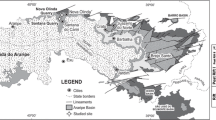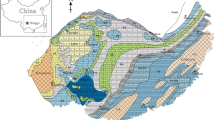Summary
Lower Devonian mud mounds and stromatactis fabrics are exceptionally well exposed in quarry walls and industrially sawed blocks in the Montagne Noire in southern France. Interlayered red biomicrites and white to grey sparitic calcites form mounds up to 70 m high. The red biomicrites contain predominantly bryozoans, sponges and echinoderms.
The sparitic layers show typical features of stromatactis fabrics, as outlined byBathurst (1982). We recognize two types of stromatactis fabrics: (1) Stromatactis type A: exentsive cavity systems filled by multiple cement generations, which are interpreted to be related to microbial mats, and (2) Stromatactis type B: smaller patches of blocky spar which are mainly diagenetic in origin, but show characteristic features of stromatactis. Type A is far more important in terms of rock volume. The cyclic interlayering of red biomicrites and sparitic layers is supposed to result from frequent changes in the composition of the mound biota.
The bryozoan/sponge community was displaced by short term propagations of microbial mats during times of extremely low sedimentation. Sedimentation and thus the biotic community was probably determined by high frequency (6th order) sea level changes. Despite these changes, mound growth continued, because once established the ecological advantage over the surroundings was maintained by both communities alternating with each other. The microbial mats and the cavities they left after their decay were important for the stabilization of the mounds, the latter allowing for enormous quantities of dissolved carbonate to be transported and precipitated. We anticipate a close interrelation between mound formation and stromatactis formation, and we believe that it is not incidential that both, mud mounds and stromatactis, are mainly restricted to the same interval, namely the Paleozoic.
Similar content being viewed by others
References
Bathurst, R. G. C. (1959): The cavernous structure of some Mississippian stromatactis reefs in Lancashire, England.— J. Geol.,67, 506–521, Chicago
— (1976): Carbonate Sediments and their Diagenesis.—Developments in Sedimentology,12, 1–658, Amsterdam (Elsevier)
— (1980): Stromatactis-origin related to submarine cemented crusts in Paleozoic mud mounds.—Geology,8, 131–134, Boulder
— (1982): Genesis of stromatactis cavities between submarine crusts in Paleozoic carbonate mud buildups.—J. geol. Soc. (London),139, 165–181, 14 figs., 1 tab., London
Bechstädt, T. (1974): Sind Stromatactis und radiaxial-fibröser Calzit Faziesindikatoren?.—N. Jb. Geol. Paläont. Mh.,1974, 643–663, Stuttgart
Belliere, J. (1953): Note sur le calcaire Famennien de Baelen et ses stromatactis.—Ann. Soc. géol. Belg.,168, 115–128, Bruxelles
Berger, G. M., Boyer, F. &Rey, J. (1990): Notice explicative de la feuille Lézignan-Corbières a 1/50 000.—70 pls., Orléans, (B.R.G.M.).
Bigey, F. &Feist, R. (1974): Cryptostomata (Bryozoaires) des Calcaires à Polypiers Siliceux” (Dévonien Inférieur de la Montagne Noire, France Meridionale). Note Préliminaire. —Docum. Lab. Géol. Fac. Sci. Lyon,3/2, 257–271, Lyon
Bourque, P. A., & Boulvain, F. (1993): A Model for the Origin and Petrogenesis of the Red Stromatactis Limestone of Paleozoic Carbonate Mounds.—J. Sed. Petrol.,63, Tulsa (in press)
Bourque, P. A. &Gignac, H. (1983): Sponge-constructed stromatactis mud mounds, Silurian of Gaspe, Quebec.—J. Sed. Petrol.,53, 521–532, Tulsa
Boyer, F. (1964): Observations stratigraphiques et structurales sur le Dévonien de la région de Caunes-Minervois (Feuille Carcassonne au 80.000 e).—Bull. Serv. Carte Géol., France,60, 105–121. Paris
Boyer, F., Krylatov, S., Le Fevre, J. &Stoppel, D. (1968): Le Dévonien supérieur et la limite dévono-carbonifère en Montagne Noire (France), Lithostratigraphie-Biostratigraphie-Conodontes. —Bull. Centre Rech. Pau—SNPA,2, 5–33, Pau
Brachert, T.C., Buggisch, W., Flügel, E., Hüssner, H. &Joachimski, M.M., Tourneur, F. &Walliser, O.H. (1992): Controls of Mud Mound Formation: The Early Devonian Kess Carbonates of the Hamar Laghdad, Antiatlas, Morocco. —Geol. Ruddschau.,81/1, 15–44, 22 figs., 4 tabs., Stuttgart
Chlupac, I. (1957): Facial development and biostratigraphy of the Lower Devonian of Central Bohemia.—Sbor. Ustr. Ust. geol. Odd. geol.,21, 91–224, Praha
Coron, R. C. &Textoris, D. A. (1974): Noncalcareous algae in a Silurian mud mound, Indiana.—J. Sed. Petrol.,44, 1249–1250, Tulsa
Dieken, G. (in prep.): Die Stromatactis-Strukturen des Suchomasty-Kalkes (Unterdevon, Barrandium).—Thesis, Aachen
Dupont, E. (1881): Sur l’origine des calcaires dévoniens de la Belgique.—Bull. Acad. r. Sci. Lett. Beaux Arts Belg.,3/2 264–280, Bruxelles
Dupont, E. (1882): Les Iles collaliennes de Roly et de Phillipville. —Bull. Mus. R. Hist. Nat. Belg., 89–160, Bruxelles
Echtler, H. &Malavielle, J. (1990): Extensional tectonics, basement uplift and Stephano-Perminan collapse basin in a late Variscan metamorphic complex (Montagne Noire, Southern Massif Centra).—Tectonophysics,177, 125–138, Amsterdam.
Engel, W., Feist, R. &Franke, W. (1982): Le Carbonifère antestéphanien de la Montagne Noire: rapport entre mise en place des nappes et sedimentation.—Bull. B.R.G.M., 2. sér., Sect I,4, 341–389, Paris
Feist, R. (1983): IUGS-Subcommission on Devonian Stratigraphy. —Field Meeting Montagne Noire, Guidebook.—56 p., Montpellier
Feist, R. (1985): Devonian Stratigraphy of the Southeastern Montagne Noire (France).—Cour. Forschinst. Senckenberg,75, 331–352, Frankfurt
Feist, R. &Groos-Uffenorde, H. (1979): Die “calcaires à polypiers siliceux” und ihre Ostracoden-Faunen (oberes Unterdevon, Montagne Noire. S.-Frankreich.—Sencken-bergiana Letheia,60, 83–187, Frankfurt
Feist, R. &Schönlaub, H. P. (1974): Zur Silur/Devon-Grenze in der östlichen Montagne Noire Südfrankreichs.—N. Jb. Geol. Paläont., Mh.,1974/4, 200–219, Stuttgart
Feist, R., Schönlaub, H. P. &Bultynck, P. (1985): Faciès et biostratigraphie (Conodontes) du passage Dévonien inférieurmoyen dans la Montagne Noire (France).—Hercynica,1, 81–97
Frech, F., (1887): Die paläozoischen Bildungen von Cabrières. —Z. dtsch. geol. Ges.,39, 360–485, Berlin.
Gerdes, G. & Krumbein, W. (1987): Biolaminated Deposits.— Lecture Notes in Earth Sciences,9, 183 p., Berlin
Géze, B. (1949): Etude géologique de la Montagne Noire et des Cevennes méridionales.—Mém. Soc. géol. France, nouv. sér.,29/62, p. 125, Paris
Heckel, P.H. (1972): Fossible inorganic origin for stromatactis in calcilutite mounds in the Tully Limestone, Devonian of New York.—J. Sed. Petrol.,42, 7–18, Tulsa
Hüssner, H. (in prep.): Plate tectonic evolution of the pre-Variscan Southern Montagne Noire as deciphered from its sedimentary record.—N. Jb. Geol. Paläont., ca. 20 pp., Stuttgart
Johnson, J. G., Klapper, G. &Sandberg, C. A. (1985): Devonian eustatic fluctuations in Euramerica.—Geol. Soc. Amer. Bull.,96, 567–587, Tulsa,
Kerans, C. (1985): Petrology of Devonian and Carboniferous carbonates of the Canning and Bonaparte basins.—West Austral. Mining Petrol. Res. Inst. Rep.,12, 1–203
Kukal, Z. (1971): Open-space structures in the Devonian Limestones of the Barrandian (Central Bohemia).—Cas. mineral. geol.,16, 345–362, Praha
Küppers, A. (1984): Conodontenstratigraphische und mikrofazielle Untersuchugen im West-Minervois (Montage Noire, Südwest-Frankreich), zwischen dem Argent-Double und dem Clamoux.—Unpublished Diploma Thesis, Aachen
Lecompte, M. (1937): Contribution a la connaissance des récifs de l’Ardennes; sur la présence de structures conservées dans des efflorescences cristallines du type “Stromatactis”. Bull. Mus. r. Hist. Nat. Belg.,13/15, 1–14, Bruxelles
— (1954): Quelques données relatives à la genése et aux caractères écologiques des “récifs” du Frasnien de l’Ardenne. —Nat. Belg. Inst. R. Sci., Vol. jubilare,1, 153–194, Bruxelles
— (1970): Die Riffe im Devon der Ardennen und ihre Bildungsbedingungen. —Geologica et Palaeontologica,4, 25–71, Marburg
Lees, A. (1964): The structure and origin of the Waulsortian (Lower Carboniferous) “reefs” of west-central Eire.—Phil. Trans. r. Soc. London,B247, 483–531, London
Lehmann, H. (1987): Mikrofazielle und conodontenstratigraphische Untersuchungen im westlichen Minervois (Montagne Noire, Südfrankreich) im Gebiet nordöstlich von Caunes-Minervois (Aude).—Unpublished Diploma Thesis, Bonn.
Logan, B. W. &Semeniuk, V. (1976): Dynamic metamorphism: processes and products in Devonian carbonate rocks, Canning Basin, Western Australia.—Spec. Publ. Geol. Soc. Austral.,6, 1–138
Marthur, A. C. (1975): A deep water mud mound facies in the Alps.—J. Sed. Petrol.,45, 787–793, Tulsa
Matyszkiewicz, J. (1993): Genesis of Stromatactis in an Upper Jurassic Carbonate Buildup (Mlynka, Poland): Internal Reworking and Erosion of Organic Growth Cavities.—Facies,28, 87–96, Erlangen
Mohr, C. G. &Van Der Mehr (1969): The stratigraphy of the Cambrian Lancara Formation between the Luna River and the Esla River in the Cantabrian Mountains, Spain.— Leidse geol. Meded,43, 233–316, Leiden
Philcox, B. R. (1963): Stromatolitic framework of carbonate mud-mounds.—J. Sed. Petrol.,52/4, 1203–1227, Tulsa
Playford, P. E. (1984): Platform-margin and marginal-slope relationships in Devonian reef complexes of the Canning Basin.—189–214, (Proc. Geol. Soc. Austral.)
Pratt, B. R. (1982): Stromatolitic Framework in Carbonate Mud Mounds.—J. Sed. Petrol.,52/4, 1203–1227, Tulsa
Riding, R. (1982): Cyanophycite calcification and changes in ocean chemistry.—Nature,299/5886, 814–815, London
— (1992): Temporal variation in calcification in marine cyanobacteria. —J. geol. Soc. (London),149, 979–989, 5 figs., London
Ross, R. J., Jaanusson, V. &Friedman, I. (1975): Lithology and origin of a Middle Ordovician calcareous mud mound at Meiklejohn Peak, Sothuern Nevada.—Prof. Pap. U.S. geol. Surv.,871, 1–48, Washington
Schmidt, H.J., (1984): Geologische und mikrofazielle Beobachtungen im Paläozoikum der “synforme de Roquebrun” (Montagne Noire).—Unpublished Diploma Thesis, Aachen
Schwarzacher, W. (1961): Petrology and structure of some Lower Carboniferous reefs in northwestern Ireland.—Amer. Assoc. Petroleum. Geol. Bull.,45, 1481–1503, Tulsa
Shinn, E. A. (1968): Burrowing in Recent lime sediments of Florida and the Bahamas.—J. Sed. Petrol.,42, 879–894, 17 figs., 4 pls., Tulsa
Textoris, D. A. &Carozzi, A. V. (1964): Petrography and evolution of Niagaran (Silurian) reefs, Indiana.—Amer. Assoc. Petrol. Geol. Bull.,48, 397–426, Tulsa
Tsien, H. H. (1985): Origin of Stromatactis—a replacement of colonial microbial accretions.—In:Toomey, D.F. &Nitecki, M.H. (eds.): Pleoalgology: Contemporary Research and Applications.—274–289, Berlin (Springer)
Vigener, M. (in prep.): Bildung und Diagenese der Stromatactis-Strukturen im Unterdevon der Montagne Noire (Frankreich).—Ph.D. Thesis, Aachen
Wallace, M. W. (1987): The role of internal erosion and sedimentation in the formation of stromatactis mudstones and associated lithologies.—J. Sed. Petrol.,57, 695–700, Tulsa
Weller, H. (1989): Das Rüberländer Mud Mound im Riffkomplex von Elbingerode (Harz) und seine sedimentologischen Eigenschaften.—Hercynia N. F.,26, 321–337, Leipzig
Author information
Authors and Affiliations
Rights and permissions
About this article
Cite this article
Flajs, G., Hüssner, H. A microbial model for the Lower Devonian stromatactis mud mounds of the Montagne Noire (France). Facies 29, 179–193 (1993). https://doi.org/10.1007/BF02536928
Received:
Accepted:
Issue Date:
DOI: https://doi.org/10.1007/BF02536928




